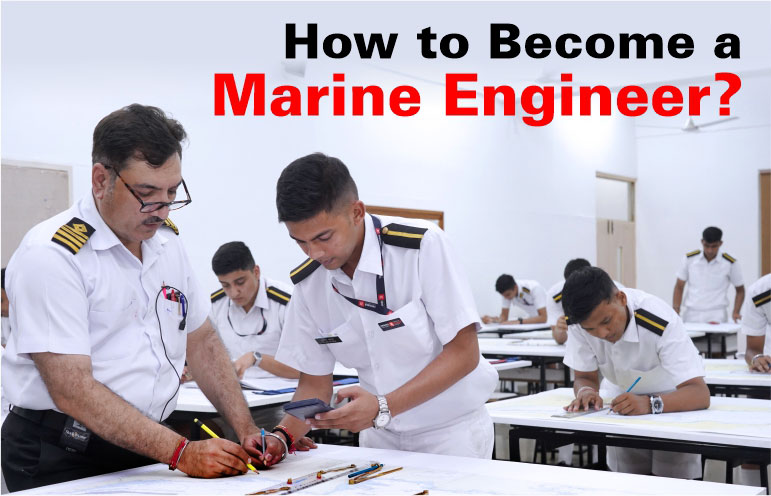Have you ever fantasised of traveling by ship to far-off ports on other continents? Have you ever fantasised of living aboard a cruise ship? Are you a technical person who enjoys science and mathematics but would rather live an unusual life than get a traditional engineering degree? If so, you could consider pursuing a career in marine engineering.
The navigation of the ships and all other non-technical operations are overseen by deck officers. The captain, who oversees all departments on board, is at the top of the hierarchy.
The efficient operation of all the mechanical, electrical, and electronic machinery, systems, and processes is the responsibility of marine engineers. The Chief Engineer, who answers to the ship’s Captain, oversees the Marine Engineering department.
Working onboard big maritime vessels like oil and CNG tankers, cruise liners (luxury passenger ships), cargo carriers, passenger carriers (ships are sometimes referred to as carriers), and military ships like aircraft carriers, frigates, and submarines is a part of marine engineering.
Also Read: Career Options At Sea: Nautical Science Vs Marine Engineering
Marine engineers are in charge of ensuring that all of the ship’s mechanical, electrical, and electronic gear, systems, and equipment operate faultlessly and as intended. All of these devices, machines and systems must be operated, repaired, and maintained by them.
After a few years of experience as an aboard marine engineer, you could also be able to locate employment prospects ashore. Work may be available in various docks or shipyards where ships are constructed and repaired. These possibilities are scarce, though.
The design, development, building, installation, repair, and maintenance of the different mechanical, electrical, and electronic equipment and systems of marine boats will be a part of your onshore job. You will be in charge of organizing the setup and testing of the different mechanical, electrical, and electronic systems.
Work as a marine engineer aboard a big marine vessel, such as a luxury cruise ship, cargo ship, passenger ship, oil tanker, or CNG tanker. You will work in shifts while on duty to make sure the ship’s mechanical, electrical, and electronic systems are all functioning properly.
Also Read: The Next Big Thing In Software Engineering Courses
You will frequently need to use your hands and spend time in the stuffy, hot engine area. Such a hands-on job will be more for you Junior Engineers early in your career. The majority of the grunt labour will be done by technicians, but you will also need to be hands-on.
The machinery on ships, boats, yachts, and other seagoing vessels is the focus of marine engineering. Other technological streams have emerged from this topic. The curriculum of the course places a strong focus on acquiring specialised knowledge in both theoretical and practical facets of mechanical and marine engineering.
Teaching the knowledge and skills necessary to operate and maintain shipboard machinery is given more importance. Nearly similar principles to those covered in standard mechanical engineering courses are taught in the first and second years of the curriculum. The main objective is to educate students about engineering sciences and show them how they are used in many aspects of maritime engineering.
Also Read: Top Ranking Engineering College In India
Utilizing the students’ maritime technical skills is the only focus of the third and fourth years. With a focus on ship operation and maintenance, both theoretical and practical elements of maritime equipment are taught.
Students gain practical expertise through laboratory and workshop teaching throughout the course of the four-year programme, enabling them to disassemble and maintain shipboard equipment.
The engineer cadet must spend the necessary time at sea after finishing the training at the Institute in order to get the experience needed to pass the engineering certificate of competency exams. You must pass these tests in order to obtain the necessary “ticket” to serve as a qualified engineer officer on board.
The entry point for a career in this area is as a deck cadet or a trainee cadet officer. For a deck officer, this training provides precise instructions on how to operate and maintain key deck gear. It is feasible to advance from Junior Officer to OOW (Officer on Watch).
The initial promotion entails the designation of Third Mate or Junior Officer. The number of years of experience necessary for this position, however, may vary depending on the shipping firm. The use of charts, avoiding collisions, navigating, using bridge equipment, managing cargo, and other tasks all call for a combination of theoretical and practical expertise. Management skills are also imparted to them.
Also Read: What Is The Difference Between Nautical Science And Marine Engineering?
Both the position of a Captain at the helm and that of an engineer aboard a ship demand exceptional health and stamina. Chief Engineer is attained through marine engineering education. Opportunities to work aboard ships and other seagoing boats are provided by this. Excellent career prospects are available in the shipping sector, which has grown in significance over the past several decades. The industry significantly aids in the development and expansion of a nation’s economy.






